The Coming of Conan Re-Read: “The Frost-Giant’s Daughter”
Bill Ward and I are working our way through the Del Rey Conan collection The Coming of Conan. This week we’re discussing “The Frost-Giant’s Daughter.” We hope you’ll join in!
Howard: Those first two paragraphs are so well written I had to stop and re-read them. Here, again, is proof of Robert E. Howard’s incredible descriptive powers. Some of that talent seems to have been innate with him, but I can’t help thinking he’s even better than he could have been because he spent so much time working with poetry, where every word counts even more than in prose. Well, actually, every word in prose should count, but too often prose writers don’t write that way. Howard at his finest always remembers this.
Bill: Indeed. There is a lot of poetic language in this one, and I think you can see the poet in the writer in much of REH’s work, just as you can with that other Weird Tales luminary, Clark Ashton Smith. Two writers with different styles, perspectives, and even goals whose prose is clearly informed by the writing of poetry. In CAS’s case he was primarily a poet, though, and I think that comes through in his work just as much as it’s obvious that REH is a born storyteller.
Howard: Absolutely. A whole lot of this story is chock full of stunning description, although, clearly, the story’s not about lovely events. A battle, its aftermath, a woman with murder in her heart and a man who lusts for her. I’ve been a little leery of this one because it wanders into uncomfortable territory.
Bill: But so does a lot of myth, classical or otherwise. By coincidence I’ve been reading Ovid’s Metamorphoses lately, and it’s been suggested (in the “Hyborian Genesis” essay at the back of the Del Rey edition we are reading, for starters) that “The Frost-Giant’s Daughter” is possibly directly inspired by the Atalanta and Daphne & Apollo myths expounded by Ovid (the name of Ymir’s daughter, Atali, also seems to support this), and transmitted to REH through his reading of Bulfinch. Injecting that “divine lover’s pursuit” motif common with Classical cultures into a wintry Nordic context is one more interesting example of the Hyborian blender that allowed REH to be so inventive and to draw upon whatever source fired his imagination.
Howard: I’m glad you did the legwork on that one, Bill. I have to agree — this isn’t Conan under “normal operating conditions.” Although Conan finds the strange woman stunningly attractive from the first, he doesn’t seem determined to have her until she weaves a kind of spell on him. That it’s a spell and not natural inclination becomes more clear closer to the end of the story when we learn that she’s a northern goddess who lures dying men from battlefields with her beauty so that her brothers can slay them — although there are many clues along the way that she’s supernatural.
From other Conan stories this kind of ravenous, animal lust is no part of his character, but I can’t help thinking that first-time Conan readers would be turned off by the situation, especially because it’s not made entirely clear this isn’t his natural state. If you’re paying attention, I think it’s obvious, but if you’re not looking for subtlety, a mistake people often make when reading REH, you might not see it. Even still, it’s an uncomfortable situation. Farnsworth Wright might have thought so as well, because he didn’t accept it for Weird Tales. Like the next story on the docket, “The God in the Bowl,” it was rejected, and never printed as a Conan tale in Howard’s lifetime.
Bill: And I scored extra nerd points this week by reading it in its reincarnated form, re-titled “Gods of the North,” in my facsimile reprint of The Fantasy Fan fanzine (March ’34). It stars “Amra of Akbitana” but is nearly identical to “The Frost-Giant’s Daughter,” though it includes a line that further details Amra’s travels in the south. This, I’m assuming, is the origin of Conan’s famous alias, and it’s great to see how the meta-events in the life of this character can turn around and influence his future fictional adventures.
And I agree, without making Conan’s magical compulsion more initially explicit, I could see “Frost-Giant” alienating readers, especially now. But Conan’s first impulse is to seek succor, to find Atali’s village, even though this woman “as beautiful as a frozen flame of hell” was standing completely naked before him.
Howard: An important point. She incites him to chase her so that she may have him killed by her brothers. He’s not in his right mind.
Bill: Right. She mocks him, dares him to follow her, draws him toward a trap, enchants him quite literally with her otherworldly beauty. Not a good call on her part, as her brother giants find out. Finally she has to call on her father Ymir, one of the North’s fierce gods who has been continually referenced in the story, to save herself. Conan had a supernatural foe in the previous story, but here he is defiant right in the teeth of divine malice, another facet of his character we see to lesser or greater degrees throughout his career.
And in terms of a career, this story is often given as the earliest in terms of internal chronology. Again, very interesting that the first two stories about Conan bracket his adventuring life, one at the very end, and one at the very start. It seems like a an organic way of discovering the character, both for us and REH. One more point against the pastiches — in forcing the stories into “career” order (and shoehorning in others, of course) it destroys the byplay between the stories — what do we see Conan mapping in “Phoenix?” The setting of the next story! Reading them in the order they were written lets us as readers share, right along with REH, in that oft-quoted phenomena of Conan simply telling us his adventures as they occur to him.
Howard: Oh, that’s a great catch Bill. I’d never noticed that wonderful juxtaposition of map maker to flashback of him in the place where he was making the map.
As to the story itself, it’s fairly simple, succeeding wholly because of Robert E. Howard’s polished prose. But, unlike next week’s tale, I find it well paced, completely achieving what it sets out to do.
Bill: In the hands of another writer it might have almost seemed a vignette, but it definitely works as a story as it stands, and the language is great. I think watching the evolution of the character and the stories themselves is possibly the most enjoyable aspect of these early stories for me, and the first three really seem to be building toward the classic trio that starts with “The Tower of the Elephant.” We’ll get to the last of these early three Conan tales next week, “The God in the Bowl.” Hope to see you here.
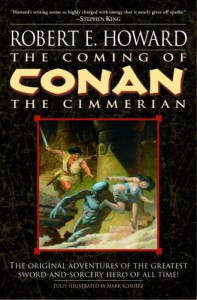
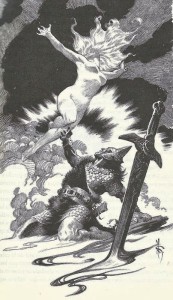
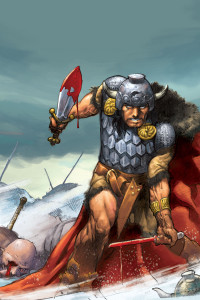
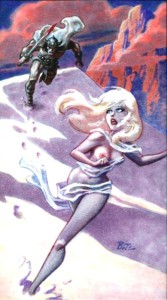
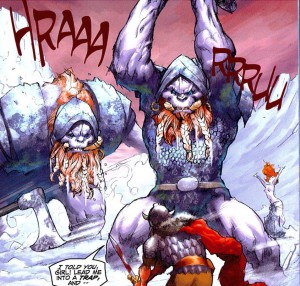
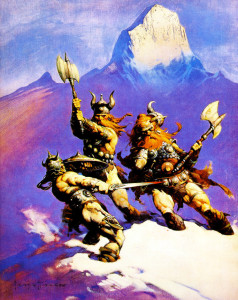
57 Comments